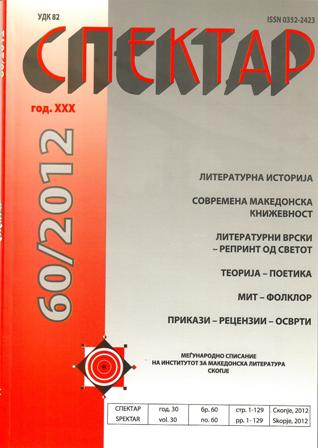DEAD MAN WALKING
ЧИТАЊЕ ЗНАЦИ ВО МАКЕДОНСКАТА БИТОВА ДРАМА
DEAD MAN WALKING READING SIGNS IN THE MACEDONIAN FOLK DRAMA
Author(s): Ana StojanoskaSubject(s): Theatre, Dance, Performing Arts, History of Art, Sociology of Literature
Published by: Институт за македонска литература
Keywords: sign; signification; semiotics; folk drama; theatre; dramatic/theatrical tradition; drama theory
Summary/Abstract: Dead man walking (Reading signs in the Macedonian folk/popular drama) is a dramatic study dedicated to the use of signs in the building of dramatic action in the Macedonian national/popular dramatics. Starting from the semiotic approach of Pierre Guiraud for the sign and its meaning, through placing of the sign aspect in the dramatic action development, the study shows how the dramatic action is defined with concrete signs. The research is focused on a larger corpus of texts from the folk drama, but it is mainly applicable to the plays of Krle, Chernodrinski, Iljovski and Molerov. The text uses results from researches of the famous Italian semiotician Umberto Eco, who explains the plot structure with the use of signs. This example makes a systematization of signs used in gist plays. Presented also is the way in which space is used in plays and in which way that space operates with the signs. Listed are concrete examples that are applicable to the claims and theses of the research itself. This is one of the rare dramatic analyses in the Macedonian theatre study which focuses directly on the research of the sign as an unavoidable element of dramatic action and the plot structure of that same action.
Journal: Спектар
- Issue Year: 2012
- Issue No: 60
- Page Range: 31-38
- Page Count: 8
- Language: Macedonian

